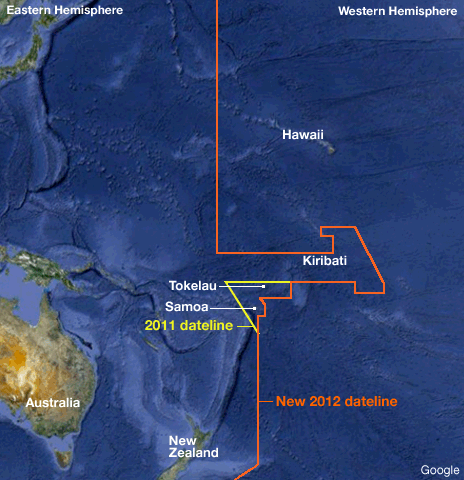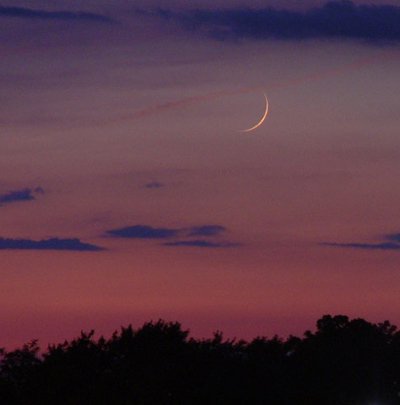
On Thursday, December 29, 2011, Samoa and Tokelau stepped west into the future, across the International Date Line. Skipping Friday, December 30th, the next day was declared to be Saturday, December 31st, 2011. There was simply no Friday in Samoa or Tokelau.
The move was purely for economic convenience. Samoa has close trading ties with Australia, New Zealand, and China. Being one day “behind” their closest neighbors cut two days (Monday and Friday) off of each work week.
 |
| http://www.bbc.co.uk/news/world-asia-16351377 |
The fact is, the International Date Line is a relatively recent man-made invention. It zig-zags its way across the Pacific and has changed several times over the years.
The International Date Line is the imaginary line on the Earth that separates two consecutive calendar days. That is the date in the Eastern hemisphere [hemiplane], to the left of the line, is always one day ahead of the date in the Western hemisphere [hemiplane]. It has been recognized as a matter of convenience and has no force in international law.
Without the International Date Line travelers going westward would discover that when they returned home, one day more than they thought had passed, even though they had kept careful tally of the days. This first happened to Magellan's crew after the first circumnavigation of the globe. Likewise, a person traveling eastward would find that one fewer days had elapsed than he had recorded, as happened to Phileas Fogg in "Around the World in Eighty Days" by Jules Verne. (“The International Date Line,” United States Naval Observatory)
The Gregorian calendar in use around the world today is a solar calendar with a continuous weekly cycle. On a solar calendar, the days and the years are measured by the sun, but the months and the weeks are purely arbitrary and have no link to anything in nature. This is what necessitated the International Date Line. It established a man-made beginning to the day to unite the whole world on one Gregorian date.So the International Date Line has proven to be a real problem for the inhabitants of Samoa. It was the difficulty of being on a day different from its surrounding neighbors that led Samoa to change the location of the International Date Line.
The International Date Line is an attempt by man to solve a man-made problem: differing weekly cycles that inevitably occur when one uses a continuous weekly cycle that is not anchored to the heavenly bodies.
 |
| Pope Gregory XIII, best known for commissioning and being the namesake for the Gregorian calendar, which remains the internationally accepted civil calendar to this date. |
However, when one chooses to follow the Luni-Solar calendar, Yahuwah is the Arbiter of time, where the moon governs the monthly and weekly cycles for your specific location. He removes ALL need of the International Date Line and thus removes ALL dependence on the Gregorian Calendar and other man-made technology. All you need is the moon to know when the months and weeks begin.
It is widely believed that the continuously cycling week in use today has come down uninterrupted from Creation, via Noah and his sons. The fact that this is not true is demonstrated by considering the various waves of immigration that took place after the flood. When Noah’s descendents emigrated from the Mountains of Ararat, some moved to the east and others to the west.
If a tribe of seventh-day Sabbath keeping Shemites moved to the East, following the rising sun, eventually, several years later, they would come to a point half way around the world. Being Sabbath keepers, they would have kept very careful track of time. Let us say, just for this example, that they had used a continuous weekly cycle. Due to the fact that they moved toward the rising sun, once they reached the far side of the world, they would be 12 hours ahead of their original starting point at Ararat.
Now consider that a tribe of seventh-day Sabbath keeping Japhethites also moved from Ararat. This tribe, however, moved to the West, following the setting sun. Being Sabbath keepers, they also would have kept a careful track of time. Again, for the sake of illustration, let us say they too used continuously cycling weeks.
A few years later, upon arriving at the same point on the other side of the world occupied by the tribe of Shemites that moved east, the tribe of Japhethites that moved west would, by the act of moving in a westerly direction, be 12 hours behind the time at Ararat. The two tribes, one having gone east, the other west, would discover that they were a full 24 hours apart from each other.
This would not be due to one group losing track. Rather, it is simply the result of one group traveling east, ahead of the daylight, and the other group traveling west, backward into the night that comes before the day.
So which group is correct? The answer is: if they had been using a continuous weekly cycle, they would both be correct, which is not possible. And herein lies the crux of the problem. This conundrum actually proves the ideology of continuously cycling weeks from Creation to be false.
As people spread out and populated the world in the centuries following the flood, they took with them the method of time-keeping used by Adam and his descendants, brought down through the flood by Noah and his sons.
This method of time-keeping, established by Yahuwah at Creation, was the Luni-Solar calendar. Unlike the solar Gregorian calendar, which uses only the sun for marking time in days and years, the Luni-Solar calendar uses both the sun and the moon for time calculation.
Like the solar Gregorian calendar, the Luni-Solar Biblical calendar uses the sun to measure days and years. Unlike the solar calendar, however, the Luni-Solar calendar uses the moon for regulating the months. This, in turn, keeps track of the seven-day weeks, because the weekly cycle restarts with each New Moon.
The result is, that if two tribes moved away from Ararat, one to the east, and the other to the west, if they encountered each other a few years later on the other side of the world, they would both be 12 hours different from their original starting point at Ararat, but they would not be 24 hours apart from each other.
 As each tribe moved, they would keep track of time by watching the moon. As the tribes moved closer together, on the far side of the world, their observation of the moon would also draw closer and closer together so that when they finally met, they would, as at the beginning of their journey, be on the same day and the same date as the other.
As each tribe moved, they would keep track of time by watching the moon. As the tribes moved closer together, on the far side of the world, their observation of the moon would also draw closer and closer together so that when they finally met, they would, as at the beginning of their journey, be on the same day and the same date as the other.
Here is seen the beauty and symmetry of the heavenly system of time-keeping. At Creation, Yahuwah specified that the lights (plural) in the heavens were to be used for marking the passage of time and all religious observances.
“And . . . [Yahuwah] said, Let there be lights in the firmament of the heaven to divide the day from the night; and let them be for signs, and for seasons, and for days, and years.” (Genesis 1:14, KJV)
The word “seasons” comes from the word mo’ed. This is a word widely used to refer to all religious gatherings. In fact, all of the feasts listed in Leviticus 23 (the first of which is the seventh-day Sabbath) are also called mo’ed.
When the Creator set aside the Sabbath day, and blessed and sanctified it as holy time, He also created a system by which people could keep track of the passage of time so that when the Sabbath came, they could know and worship Him. It took both the sun and the moon to create this perfect system of time-keeping.
As the anchor to the months and the weeks, the moon regulates time accurately, no matter where you are on Earth. Thus, were a tribe of Shemites to move east and a tribe of Japhethites to move west and reunite a few years later, they would be united on the same weekly schedule because the basis for their weekly count is anchored in the heavens. It is not grounded on any man-made institution.
Scripture explicitly states that the moon was created to mark the passage of time:
“He appointed [created] the moon for seasons [mo’ed]: the sun knoweth his going down.” (Psalm 104:19)
 Because the modern weekly cycle has no ties to anything in nature, problems arise that do not exist in the Luni-Solar calendar of Creation: specifically, the need for an arbitrary International Date Line. A continuous weekly cycle, anchored to nothing in nature, is a man-made institution. The International Date Line is simply a man-made solution to what is nothing more than a man-made problem.
Because the modern weekly cycle has no ties to anything in nature, problems arise that do not exist in the Luni-Solar calendar of Creation: specifically, the need for an arbitrary International Date Line. A continuous weekly cycle, anchored to nothing in nature, is a man-made institution. The International Date Line is simply a man-made solution to what is nothing more than a man-made problem.
On the counterfeit pagan/papal calendar, months are arbitrary and dates have an artificial starting point at the International Date Line – which is itself arbitrary and moveable. Only on the Biblical calendar are months and dates anchored to the lights in the heavens which were given for the express purpose of regulating time.
Yahuwah’s calendar, using the combined action of the sun and the moon for marking the passage of days, weeks, months, and years, will stand forever. It forms an integral part of the very structure of the heavens. It can be witnessed and used by everyone on earth, and accurately regulates time and holy days.
“It shall be established forever like the moon, even like the faithful witness in the sky." (Psalm 89:37)
Which calendar will you choose to use for worship – man’s or Yahuwah’s?